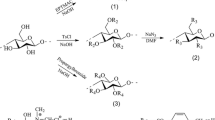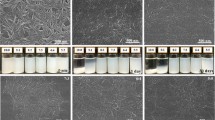Abstract
Deposition of nanoparticles on the surface of a variety of materials is a subject of great interest due to their potential applications in electronic devices, sensing, catalysis and bio-medical sciences. In this context, we have explored and compared various methodologies to generate gold and silver nanoparticles on the surface of cellulose fibers. It was found that boiling of the cellulose fibers in alkaline solution of gold and silver salts led to the formation and immobilization of gold and silver nanoparticles. However, in case of lecithin treated and thiol-modified cellulose fibers, high temperature was not essentially required for the formation and deposition of nanoparticles on cellulose substrate. In both these cases, fairly uniform metal nanoparticles were obtained in good yields (~43 wt% gold loading in case of thiol modified cellulose fibers) at room temperature. Borohydride-reduction method resulted in relatively lower loading (~22 wt%) with a wide size distribution of gold and silver nanoparticles on cellulose fibers. All these nanoparticle–cellulose composites were thoroughly characterized using scanning electron microscopy, energy dispersive X-ray, Fourier transform infrared spectroscopy, UV–visible spectroscopy, and elemental analyzer. Thiol modified cellulose–gold nanoparticle composites served as active catalysts in the reduction of 4-nitrophenol into 4-aminophenol.






Similar content being viewed by others
References
Baker GA, Moore DS (2005) Progress in plasmonic engineering of surface-enhanced Raman-scattering substrates toward ultra-trace analysis. Anal Bioanal Chem 382(8):1751–1770
Barud HS, Barrios C, Regiani T, Marques RFC, Verelst M, Dexpert-Ghys J, Messaddeq Y, Ribeiro SJL (2008) Self-supported silver nanoparticles containing bacterial cellulose membranes. Mater Sci Eng C 28(4):515–518
Cai J, Kimura S, Wada M, Kuga S (2008) Nanoporous cellulose as metal nanoparticles support. Biomacromolecules 10(1):87–94
Chen J, Wang J, Zhang X, Jin Y (2008) Microwave-assisted green synthesis of silver nanoparticles by carboxymethyl cellulose sodium and silver nitrate. Mater Chem Phys 108(2–3):421–424
de Santa Maria LC, Santos ALC, Oliveira PC, Barud HS, Messaddeq Y, Ribeiro SJL (2009) Synthesis and characterization of silver nanoparticles impregnated into bacterial cellulose. Mater Lett 63(9–10):797–799
Dong BH, Hinestroza JP (2009) Metal nanoparticles on natural cellulose fibers: electrostatic assembly and in situ synthesis. ACS Appl Mater Interface 1(4):797–803
Drogat N, Granet R, Sol V, Memmi A, Saad N, Klein Koerkamp C, Bressollier P, Krausz P (2011) Antimicrobial silver nanoparticles generated on cellulose nanocrystals. J Nanopart Res 13(4):1557–1562
Egal M, Budtova T, Navard P (2008) The dissolution of microcrystalline cellulose in sodium hydroxide–urea aqueous solutions. Cellulose 15(3):361–370
El-Shishtawy RM, Asiri AM, Abdelwahed NAM, Al-Otaibi MM (2011) In situ production of silver nanoparticle on cotton fabric and its antimicrobial evaluation. Cellulose 18(1):75–82
Ferraria AM, Boufi S, Battaglini N, Botelho do Rego AM, ReiVilar M (2009) Hybrid systems of silver nanoparticles generated on cellulose surfaces. Langmuir 26(3):1996–2001
He J, Kunitake T, Nakao A (2003) Facile in situ synthesis of noble metal nanoparticles in porous cellulose fibers. Chem Mater 15(23):4401–4406
Hetrick EM, Schoenfisch MH (2006) Reducing implant-related infections: active release strategies. Chem Soc Rev 35(9):780–789
Huang H, Yuan Q, Yang X (2004) Preparation and characterization of metal–chitosan nanocomposites. Colloids Surf B 39(1–2):31–37
Hussain I, Hussain SZ, Ihsan A, Rehman A, Khalid ZM, Brust M, Cooper AI (2010) In situ growth of gold nanoparticles on latent fingerprints—from forensic applications to inkjet printed nanoparticle patterns. Nanoscale 2(12):2575–2578
Iwata T, Kimura Y, Tsutsumi K, Furukawa Y, Kimura S (1993) The effect of various phospholipids on plasma lipoproteins and liver lipids in hypercholesterolemic rats. J Nutr Sci Vitaminol 39(1):63–71
Jimenez MA, Scarino ML, Vignolini F, Mengheri E (1990) Evidence that polyunsaturated lecithin induces a reduction in plasma cholesterol level and favorable changes in lipoprotein composition in hypercholesterolemic rats. J Nutr 120(7):659–667
John MJ, Thomas S (2008) Biofibres and biocomposites. Carbohydr Polym 71(3):343–364
Kesting RE (1965) Semipermeable membranes of cellulose acetate for desalination in the process of reverse osmosis. I. Lyotropic swelling of secondary cellulose acetate. J Appl Polym Sci 9(2):663–688
Kotelnikova N, Panarin E, Shchukarev A, Serimaa R, Paakkari T, Jokela K, Shilov S, Kudina N, Wegener G, Windeisen E (1999) The effect of quaternary ammonium base adsorbates on the molecular and morphological structure of microcrystalline cellulose. Carbohydr Polym 38(3):239–246
Kwon JW, Yoon SH, Lee SS, Seo KW, Shim IW (2005) Preparation of silver nanoparticles in cellulose acetate polymer and the reaction chemistry of silver complexes in the polymer. Bull Korean Chem Soc 26(5):837–840
Lee HY, Park HK, Lee YM, Kim K, Park SB (2007) A practical procedure for producing silver nanocoated fabric and its antibacterial evaluation for biomedical applications. Chem Commun 28:2959–2961
Liu S, Ke D, Zeng J, Zhou J, Peng T, Zhang L (2011a) Construction of inorganic nanoparticles by micro–nano-porous structure of cellulose matrix. Cellulose 18(4):945–956
Liu S, Zhou J, Zhang L (2011b) In situ synthesis of plate-like Fe2O3 nanoparticles in porous cellulose films with obvious magnetic anisotropy. Cellulose 18(3):663–673
Lu Q, Gao F, Komarneni S (2006) Cellulose-directed growth of selenium nanobelts in solution. Chem Mater 18(1):159–163
Luong ND, Lee Y, Nam JD (2008) Highly-loaded silver nanoparticles in ultrafine cellulose acetate nanofibrillar aerogel. Eur Polym J 44(10):3116–3121
Mahmoud KA, Male KB, Hrapovic S, Luong JHT (2009) Cellulose nanocrystal/gold nanoparticle composite as a matrix for enzyme immobilization. ACS Appl Mater Interface 1(7):1383–1386
Rotello VM (2004) Nanoparticles: building blocks for nanotechnology. Springer, New York
Sarrazin P, Beneventi D, Chaussy D, Vurth L, Stephan O (2009) Adsorption of cationic photoluminescent nanoparticles on softwood cellulose fibres: effects of particles stabilization and fibres’ beating. Colloids Surf A 334(1–3):80–86
Sergeev GB (2006) Nanochemistry. Elsevier Science, Amsterdam
Serp P, Corrias M, Kalck P (2003) Carbon nanotubes and nanofibers in catalysis. Appl Catal A Gen 253(2):337–358
Shipway AN, Katz E, Willner I (2000) Nanoparticle arrays on surfaces for electronic, optical and sensor applications. ChemPhysChem 1(1):18–52
Son WK, Youk JH, Lee TS, Park WH (2004) Preparation of antimicrobial ultrafine cellulose acetate fibers with silver nanoparticles. Macromol Rapid Commun 25(18):1632–1637
Tankhiwale R, Bajpai S (2009) Graft copolymerization onto cellulose-based filter paper and its further development as silver nanoparticles loaded antibacterial food-packaging material. Colloids Surf B 69(2):164–168
Taylor P, Omotoso O, Wiskel J, Mitlin D, Burrell R (2005a) Impact of heat on nanocrystalline silver dressings. Part II: physical properties. Biomaterials 26(35):7230–7240
Taylor P, Ussher A, Burrell R (2005b) Impact of heat on nanocrystalline silver dressings. Part I: chemical and biological properties. Biomaterials 26(35):7221–7229
Wang Y, Yang Q, Shan G, Wang C, Du J, Wang S, Li Y, Chen X, Jing X, Wei Y (2005) Preparation of silver nanoparticles dispersed in polyacrylonitrile nanofiber film spun by electrospinning. Mater Lett 59(24–25):3046–3049
Wu M, Kuga S, Huang Y (2008) Quasi-one-dimensional arrangement of silver nanoparticles templated by cellulose microfibrils. Langmuir 24(18):10494–10497
Wu J, Zhao N, Zhang X, Xu J (2012) Cellulose/silver nanoparticles composite microspheres: eco-friendly synthesis and catalytic application. Cellulose 19(4):1239–1249
Acknowledgments
We acknowledge the Higher Education Commission (HEC), Government of Pakistan, for financial support to Dr. Sumaira Ashraf for her PhD studies. We are also thankful to ex-National Commission on Nanoscience and Technology (NCNST) and the Ministry of Science and Technology (MoST), Government of Pakistan, for financial support to initiate nano-biotechnology research at NIBGE. IH thanks LUMS School of Science and Engineering (SSE), Lahore, Pakistan for providing start-up funds and supporting his research team. A part of this work was supported by DAAD project (ID 54372132) awarded to IH and Wolfgang J. Parak at Philipps University, Marburg, Germany. We are also thankful to Professor Wolfgang Parak for his support in characterizing the nanoparticle samples and intellectual discussion.
Author information
Authors and Affiliations
Corresponding author
Electronic supplementary material
Below is the link to the electronic supplementary material.
Rights and permissions
About this article
Cite this article
Ashraf, S., Saif-ur-Rehman, Sher, F. et al. Synthesis of cellulose–metal nanoparticle composites: development and comparison of different protocols. Cellulose 21, 395–405 (2014). https://doi.org/10.1007/s10570-013-0129-7
Received:
Accepted:
Published:
Issue Date:
DOI: https://doi.org/10.1007/s10570-013-0129-7




